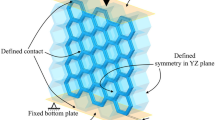Abstract
In this paper, two new 2D re-entrant topologies with negative Poisson’s ratio are presented and their mechanical properties (Poisson’s ratio and energy absorption capacity) are studied using finite element method as a function of geometric parameters. The first topology (model 1) was constructed by adding two sinusoidal-shaped ribs into the classical re-entrant topology, while the second topology (model 2) was made by introducing extra vertical ribs to reinforce the sinusoidal-shaped ribs. Simulation results show that model 1 and model 2 topologies can reach a minimum value in Poisson’s ratio of − 1.12 and − 0.58 with an appropriate geometric aspect ratio, respectively. The energy absorption capacities of model 1, model 2 and classical re-entrant model were studied at various compression velocities. Enhanced energy absorption capacities were observed in the two new re-entrant topologies compared with the classical re-entrant topology. Model 2 exhibited the highest energy absorption capacity and a highest plateau stress. The plateau stress of model 1 was about half that of model 2, and when the compression velocity is more than 20 m/s, the plateau stress of model 1 became lower than that of the classical re-entrant model.




Similar content being viewed by others
References
Gibson LJ, Ashby MF (1988) Cellular solids: structure & properties. Pergamon Press, Oxford
Noll W, Antman SS, Truesdell C (2004) The non-linear field theories of mechanics. Springer, Berlin
Wojciechowski KW (2007) Remarks on “Poisson ratio beyond the limits of the elasticity theory”. J Phys Soc Jpn 72(7):1819–1820
Lempriere BM (1968) Poisson’s ratio in orthotropic materials. AIAA J 6:2226–2227
Ting TCT, Chen T (2005) Poisson’s ratio for anisotropic elastic materials can have no bounds. Q J Mech Appl Math 58:73–82
Grima JN, Caruanagauci R, Wojciechowski KW, Evans KE (2013) Smart hexagonal truss systems exhibiting negative compressibility through constrained angle stretching. Smart Mater Struct 22(8):084015
Li D, Dong L, Yin J, Lakes RS (2016) Negative Poisson’s ratio in 2D Voronoi cellular solids by biaxial compression: a numerical study. J Mater Sci 51:7029–7037. https://doi.org/10.1007/s10853-016-9992-6
Friis EA, Lakes RS, Park JB (1988) Negative Poisson’s ratio polymeric and metallic foams. J Mater Sci 23:4406–4414. https://doi.org/10.1007/BF00551939
Webber RS, Alderson KL, Evans KE (2008) A novel fabrication route for auxetic polyethylene: II. Mech Prop Polym Eng Sci 48:1351–1358
Lakes RS, Elms KE (1993) Indentability of conventional and negative Poisson’s ratio foams. J Compos Mater 27:1193–1202
Chan N, Evans KE (1998) Indentation resilience of conventional and auxetic foams. J Cell Plast 34:231–260
Scarpa F, Tomlin PJ (2000) On the transverse shear modulus of negative Poisson’s ratio honeycomb structures Fatigue. Eng Mater Struct 23:717–720
Scarpa F, Ciffo LG, Yates JR (2004) Dynamic properties of high structural integrity auxetic open cell foam. Smart Mater Struct 13:49–56
Gibson LJ, Ashby MF, Schajer GS, Robertson CI (1982) The mechanics of two-dimensional cellular materials. Proc R Soc Lond A382:25–42
Kolpakov AG (1985) On the determination of the averaged moduli of elastic gridworks. Prikl Mat Mekh 59:969–977
Hirotsu S (1991) Softening of bulk modulus and negative Poisson’s ratio near the volume phase transition of polymer gels. J Chem Phys 94:3949–3957
Hirotsu S (1990) Elastic anomaly near the critical point of volume phase transition in polymer gels. Macromolecules 23:903–905
Rovati M (2003) On the negative Poisson’s ratio of an orthorhombic alloy. Scr Mater 48:235–240
Dong L, Stone DS, Lakes RS (2010) Softening of bulk modulus and negative Poisson ratio in barium titanate ceramic near the Curie point Phil. Mag Lett 90:23–33
Li D, Jaglinski TM, Stone DS, Lakes RS (2012) Temperature insensitive negative Poisson’s ratios in isotropic alloys near a morphotropic phase boundary. Appl Phys Lett 101:251903
Hu H, Silberschmidt V (2013) A composite material with Poisson’s ratio tunable from positive to negative values: an experimental and numerical study. J Mater Sci 48:8493–8500. https://doi.org/10.1007/s10853-013-7666-1
Kaminakis NT, Stavroulakis GE (2012) Topology optimization for compliant mechanisms, using evolutionary-hybrid algorithms and application to the design of auxetic. Mater Compos Part B 43:2655–2668
Pozniak AA, Smardzewski J, Wojciechowski KW (2013) Computer simulations of auxetic foams in two dimensions. Smart Mater Struct 22:1–11
Li D, Dong L, Lakes RS (2016) A bi-material structure with Poisson’s ratio tunable from positive to negative via temperature control. Mater Lett 164:456–459
Baughman RH, Shacklette JM, Zakhidov AA, Stafstrom S (1998) Negative Poisson’s ratios as a common feature of cubic metals. Nature 392:362–365
Grima JN, Evans KE (2000) Auxetic behavior from rotating squares. J Mater Sci Lett 19:1563–1565
Scarpa F, Blain S, Lew T, Perrott D, Ruzzene M, Yates JR (2007) Elastic buckling of hexagonal chiral cell honeycombs Compos A 38:280–289
Wojciechowski KW (1989) Two-dimensional isotropic system with a negative poisson ratio. Phys Lett A 137:60–64
Li D, Dong L, Lakes RS (2013) The properties of copper foams with negative Poisson’s ratio via resonant ultrasound spectroscopy. Phys Status Solidi B 250:1983–1987
Lakes RS (1987) Negative Poisson’s ratio materials. Science 238:551
Prawoto Y (2012) Seeing auxetic materials from the mechanics point of view: a structural review on the negative Poisson’s ratio. Comput Mater Sci 58:140–153
Jones D (2001) Handbook of viscoelastic vibration damping. Wiley, New York
Zi-Xing Lu, Li Xiang, Yang Zhen-Yu, Xie Fan (2016) Novel structure with negative Poisson’s ratio and enhanced Young’s modulus. Compos Struct 138:243–252
Evans KE, Nkansah MA, Hutchinson IJ, Rogers SC (1991) Molecular network design. Nature 353:124–125
Acknowledgements
This work is supported by “The Fundamental Research Funds for the Central Universities (N150504006)”.
Author information
Authors and Affiliations
Corresponding author
Ethics declarations
Conflict of interest
Authors declare that no conflicting interests affected this research. Authors declare that no conflicting interests affected the objective presentation and description of results.
Rights and permissions
About this article
Cite this article
Li, D., Yin, J., Dong, L. et al. Strong re-entrant cellular structures with negative Poisson’s ratio. J Mater Sci 53, 3493–3499 (2018). https://doi.org/10.1007/s10853-017-1809-8
Received:
Accepted:
Published:
Issue Date:
DOI: https://doi.org/10.1007/s10853-017-1809-8




